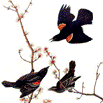Center, Internet, Wildlife Damage Management

Bird Control Seminars Proceedings
Document Type
Article
Date of this Version
10-1983
Citation
Proceedings Ninth Bird Control Seminar, Bowling Green State University, Bowling Green, Ohio, October 4-6, 1983. Ed. William B. Jackson and Beth Jackson Dodd
Abstract
Nonlethal chemical repellents are being vigorously investigated to control wildlife feeding in agriculture and silviculture and thus alleviate damages to food, feed, and fibre. Unfortunately, few effective avian repellents have emerged, partly because workers tend to be anthropomorphic in their basic assumptions about target species and repellent action (Rogers, 1978), and partly due to the lack of knowledge of the feeding behavior of the target species (McKey, 1974). Rogers (1978) advocated natural chemical defenses of plants against herbivores as starting points for studies dealing with repellent development. Rogers (1978) defined repellents as a "compound or combination of compounds that, when added to a food source, acts through the taste system to produce a marked decrease in the utilization of that food by the target species." He separated repellents into primary repellents, where the animal reacts to the taste of the repellent alone, and secondary repellents, where the animal uses the taste of the repellent as a cue to other later physiological adverse effects. Most of the successful repellents have been secondary repellents (Bullard et aI., 1983a,b), but few investigators have looked at the reasons behind the ineffectiveness of primary repellents in topical applications.


Comments
Copyright (c) 1983 M. H. Zeinelabdin, R. W. Bullard and W. B. Jackson